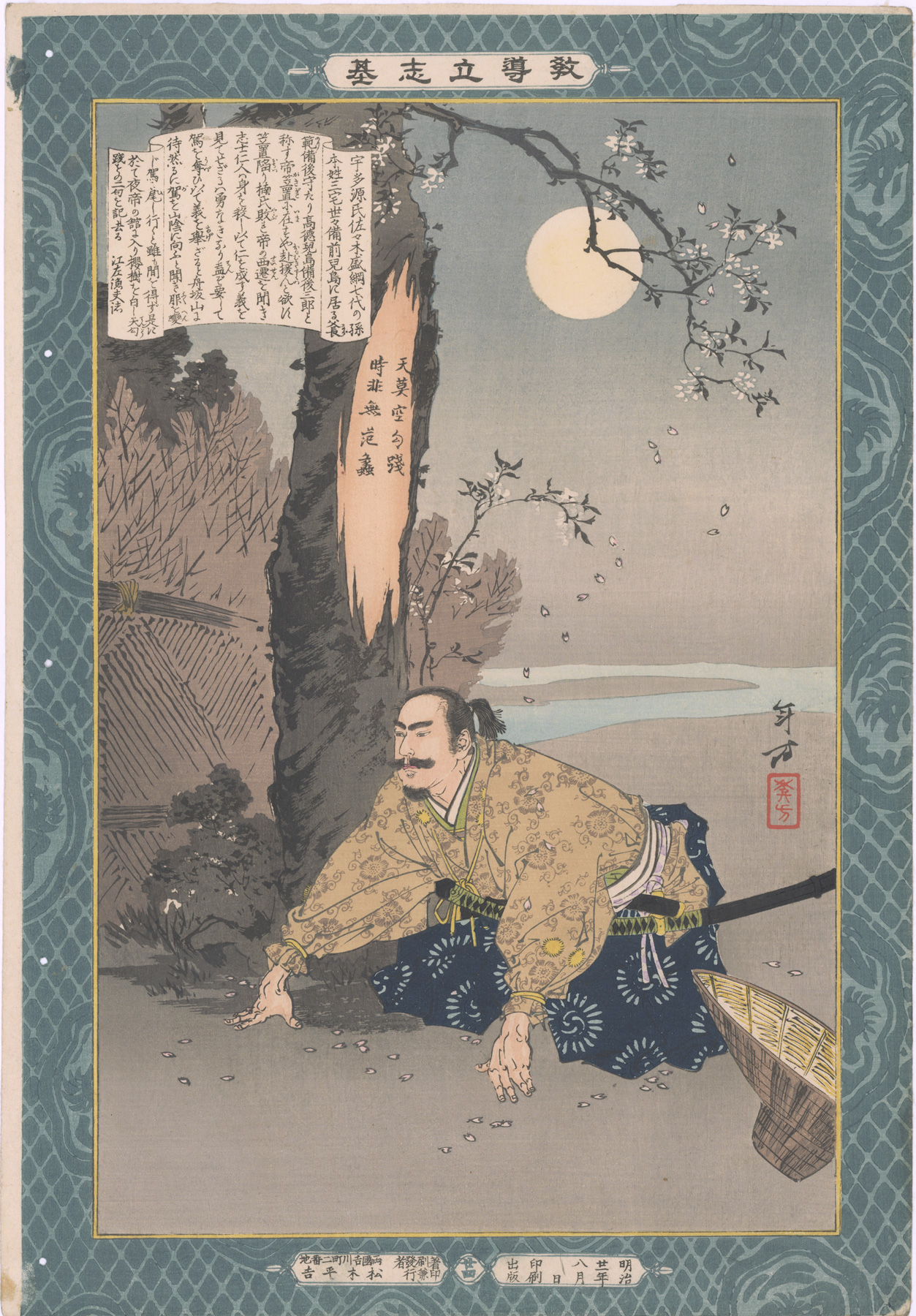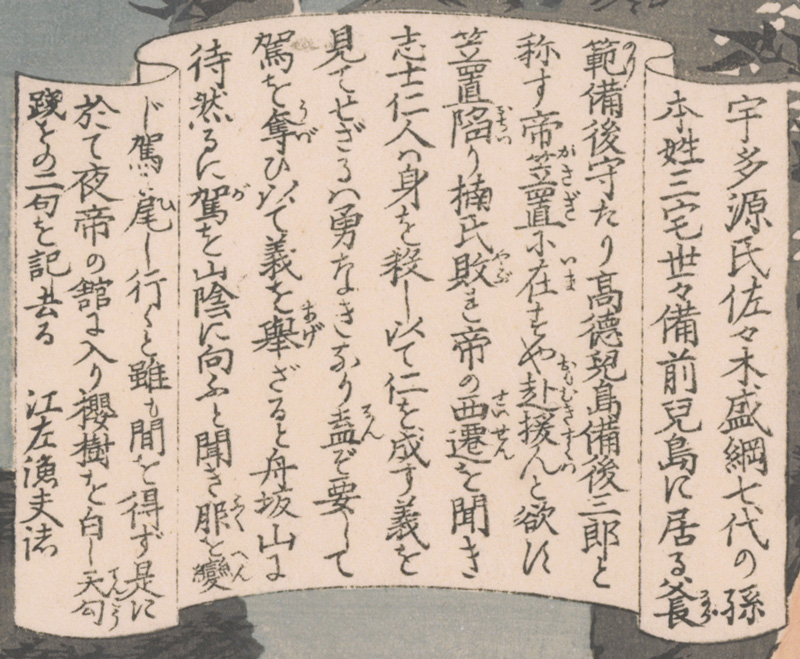About This Print
Print number 廿四 [24] in the series Instructive Models of Lofty Ambition picturing the fourteenth-century daimyō Kojima Takanori 児島高徳 kneeling before the cherry tree upon which he has carved a poem to his exiled emperor Go Daigo. The poem is meant to be seen by Go Daigo on his way into exile on one of the Oki Islands in Bizen Provence.The artist Mizuno Toshikata contributed 16 prints to this series.
1 Numbering of the prints was haphazard during the production of the series. Print numbers were sometimes inadvertently omitted; some prints in the series were never assigned numbers and a few of the same numbers appear on different prints.
Kojima Takanori (d. 1358) and Emperor Go Daigo (1288-1339)
Sources: Legend in Japanese Art: A Description of Historical Episodes, Legendary Characters, Folk-lore Myths, Religious Symbolism, Henri L. Joly, Henri L, John Lane and The Bodley Head, 1908, p. 96 and Japanese Historians and the National Myths, 1600-1945: TheAge of the Gods and Emperor Jinmu, John S. Brownlee, UBC Press, 2011, p. 87.In 1331, Emperor Go-Daigo (1288-1339) was deposed and sent into exile by the Hōjō family. Takanori, a loyal supporter of the Emperor, disguised himself as a peasant and tracked the Emperor to the small inn on the border of Bizen province. As a message to the Emperor, Takanori rips a patch of bark off the cherry tree and writes a classical Chinese poem of loyalty, recounting how the King of Yue was saved by his loyal retainer, Huan Lei. Although the Emperor was heartened by the poem, it was two more years before he was reinstated.
The poem reads:
天莫空勾踐 Ten Kōsen no Munashu suru nakare,
時非無范姦 Toki ni Hanrei nake ni shimo arazu
Transcription of Scroll
Source: with thanks to Yajifun http://yajifun.tumblr.com/
24 KojimaTakanori 児島高徳
教導立志基 廿四 児島高徳 水野年方 1888年8月
廿四 (24) 明治21(1888)・08・
Transcription:
“宇多源氏佐々木盛綱七代の孫 本姓三宅 世々備前兒島(児島)に居る 父長範備後守たり 高徳兒島備後三郎と称す 帝笠置に在すや赴援(おもむきすくわ)んと欲す 笠置陥り楠氏敗れ帝の西遷を聞き 志士仁人ハ身を殺し以て仁を成す 義を見てせざるハ勇なきなり 盍(なん)ぞ要して駕を奪ひ以て義を擧(挙)ざる と舟坂山に待 然るに駕を山陰に向ふと聞き服を變(変)じ駕に尾し行くと雖も間を得ず是に於て夜 帝の舘に入り櫻樹(桜樹)を白し 天勾践を の二句を記し去る 江左漁夫 誌 「天莫空勾踐 時非無茫蠡」”
About The Series "Kyōdō risshi no motoi"
Notes:1. This series is variously translated as "Instructive Models of Lofty Ambition," "Foundations of Learning and Achievement," "Foundation of Instruction and Perseverance," "Self-Made Men Worthy of Emulation," "Paragons of Instruction and Success," "Moral of Success," "Examples of Self-Made Leaders," and "Instruction in the Fundamentals of Success." The title in Japanese is sometimes seen as "Kyōdō risshiki or "Kyōdō risshi no moto," in addition to the most commonly seen transliteration of "Kyōdō risshi no motoi".2. For a complete listing of all the prints in the series and additional information please see the article on this site titled Instructive Models of Lofty Ambition.
This series ran between October 1885 and November 1890 and featured a long list of heroes and heroines, from antiquity to contemporary times, who were regarded as standards of moral leadership and self-realization.
This series ran between October 1885 and November 1890 and featured a long list of heroes and heroines, from antiquity to contemporary times, who were regarded as standards of moral leadership and self-realization.
Source: Kiyochika Artist of Meiji Japan, Henry D. Smith II, Santa Barbara Museum of Art, 1988, p. 74-75; original research and as footnoted.
This series of 58 prints,1 plus a table of contents sheet (目録), were originally published between October 1885 and November 1890 by the Tokyo publisher Matsuki Heikichi 松木平吉.2 The table of contents sheet issued by the publisher states that "fifty prints make up the complete set (五十番揃)". Three prints not in the initial release were added over the five year publication period, as were five redesigns of original prints, eventually increasing the total print count to 58. The seven artists contributing prints were Kobayashi Kiyochika (1847-1915) [20 prints], Mizuno Toshikata (1866-1908) [16 prints], Inoue Tankei (Yasuji) (1864-1889) [13 prints], Taiso (Tsukioka) Yoshitoshi (1839-1892) [5 prints], Yōshū Chikanobu (1838-1912) [2 prints], Toyohara Kunichika (1835–1900) [1 print], and Hachisuka (Utagawa) Kuniaki II (1835-1888) [1 print]. All the artists, with the exception of Yōshū Chikanobu, are listed in the top scroll of the table of contents sheet. Various colors (including blue, blue/green, and tan/brown) were used for the decorative border, and in 1902 the series was re-issued by Matsuki without borders.
Brief texts contained within a scroll-like cartouche appearing on each print provide historical details. The scroll composer's name is given at the end of the scroll text. The “lofty ambition” of the title is a Confucian concept, originally from Mencius, meaning “righteous determination that would inspire others.” The market for the series probably included former samurai, ambitious youth, and conservative intellectuals.
"[W]hen it was completed in 1890 the publisher was singled out for special recognition by the government for having sponsored such noble subject matter."3
Source: Kiyochika Artist of Meiji Japan, Henry D. Smith II, Santa Barbara Museum of Art, 1988, p. 74-75; original research and as footnoted.
This series of 58 prints,1 plus a table of contents sheet (目録), were originally published between October 1885 and November 1890 by the Tokyo publisher Matsuki Heikichi 松木平吉.2 The table of contents sheet issued by the publisher states that "fifty prints make up the complete set (五十番揃)". Three prints not in the initial release were added over the five year publication period, as were five redesigns of original prints, eventually increasing the total print count to 58. The seven artists contributing prints were Kobayashi Kiyochika (1847-1915) [20 prints], Mizuno Toshikata (1866-1908) [16 prints], Inoue Tankei (Yasuji) (1864-1889) [13 prints], Taiso (Tsukioka) Yoshitoshi (1839-1892) [5 prints], Yōshū Chikanobu (1838-1912) [2 prints], Toyohara Kunichika (1835–1900) [1 print], and Hachisuka (Utagawa) Kuniaki II (1835-1888) [1 print]. All the artists, with the exception of Yōshū Chikanobu, are listed in the top scroll of the table of contents sheet. Various colors (including blue, blue/green, and tan/brown) were used for the decorative border, and in 1902 the series was re-issued by Matsuki without borders.
This series of 58 prints,1 plus a table of contents sheet (目録), were originally published between October 1885 and November 1890 by the Tokyo publisher Matsuki Heikichi 松木平吉.2 The table of contents sheet issued by the publisher states that "fifty prints make up the complete set (五十番揃)". Three prints not in the initial release were added over the five year publication period, as were five redesigns of original prints, eventually increasing the total print count to 58. The seven artists contributing prints were Kobayashi Kiyochika (1847-1915) [20 prints], Mizuno Toshikata (1866-1908) [16 prints], Inoue Tankei (Yasuji) (1864-1889) [13 prints], Taiso (Tsukioka) Yoshitoshi (1839-1892) [5 prints], Yōshū Chikanobu (1838-1912) [2 prints], Toyohara Kunichika (1835–1900) [1 print], and Hachisuka (Utagawa) Kuniaki II (1835-1888) [1 print]. All the artists, with the exception of Yōshū Chikanobu, are listed in the top scroll of the table of contents sheet. Various colors (including blue, blue/green, and tan/brown) were used for the decorative border, and in 1902 the series was re-issued by Matsuki without borders.
Brief texts contained within a scroll-like cartouche appearing on each print provide historical details. The scroll composer's name is given at the end of the scroll text. The “lofty ambition” of the title is a Confucian concept, originally from Mencius, meaning “righteous determination that would inspire others.” The market for the series probably included former samurai, ambitious youth, and conservative intellectuals.
"[W]hen it was completed in 1890 the publisher was singled out for special recognition by the government for having sponsored such noble subject matter."3
1 The Tokyo Metropolitan Library online collection shows 50 prints and a Table of Contents sheet. The Table of Contents lists the titles of 50 prints. Smith in Kiyochika Artist of Meiji Japan identified 52 prints. I have identified 58 prints from this series including five prints (Ikina, Michizane Sugiwara, Kesa Gozen, Soga Brothers and Hokiichi Hanawa) that were re-designed and re-printed, likely due to damaged or lost blocks.
2 Robert Schaap notes in Appendix II, p. 166 of Yoshitoshi, Masterpieces from the Ed Freis Collection, Chris Uhlenbeck and Amy Reigle Newland, Hotei Publishing, 2011 that the series originally appeared as newspaper supplements.
3 The World of the Meiji Print: Impressions of a New Civilization, Julia Meech-Pekarik, Weatherhill, 1986, p. 122.
1 The Tokyo Metropolitan Library online collection shows 50 prints and a Table of Contents sheet. The Table of Contents lists the titles of 50 prints. Smith in Kiyochika Artist of Meiji Japan identified 52 prints. I have identified 58 prints from this series including five prints (Ikina, Michizane Sugiwara, Kesa Gozen, Soga Brothers and Hokiichi Hanawa) that were re-designed and re-printed, likely due to damaged or lost blocks.
2 Robert Schaap notes in Appendix II, p. 166 of Yoshitoshi, Masterpieces from the Ed Freis Collection, Chris Uhlenbeck and Amy Reigle Newland, Hotei Publishing, 2011 that the series originally appeared as newspaper supplements.
3 The World of the Meiji Print: Impressions of a New Civilization, Julia Meech-Pekarik, Weatherhill, 1986, p. 122.
Print Details
IHL Catalog
#1403 Title or Description Kojima Takanori 児島高徳 Series “Instructive Models of Lofty Ambition” (Kyodo risshiki 教導立志基) [note: series title also listed as 'Kyodo Risshi no Moto', ‘Kyodo risshi no motoi’, ‘Kyōdō risshi ki’ and variously translated as “Moral of success” or “Foundations of learning and achievement” or “Self-made Men Worthy of Emulation”' or “Examples of Self-made Leaders” or "Paragons of instruction and success"] Artist Mizuno Toshikata (1866-1908)
Signature  年方 Toshikata
年方 Toshikata
Seal of the artist Toshikata 年方 seal as shown above Publication Date August 1888 明治廿一年八月 日 Publisher Matsuki Heikichi (松木平吉) proprietor of Daikokuya Heikichi [Marks: seal not shown; pub. ref. 029]
(from right to left)
publishing and printing date: 明治廿一年八月 日 印刷 出版[Meiji 21st year 8th month, printing and publication]
assigned number within series: 廿四 [24]
publisher information: 著印刷兼発行者 両国吉川町二番地 松木平吉 [printer and publisher Ryōgoku Yoshikawachō 2-banchi Matsuki Heikichi] Impression excellent
Colors excellent Condition good - almost full-size; minor marks; five small binding holes along left edge
Genre ukiyo-e; rishki-e; kyōiku nishiki-e Miscellaneous position 24 in the Table of Contents for the series Format vertical oban
H x W Paper
14 1/2 x 9 15/16 in. (36.8 x 25.2 cm)
H x W Image
14 3/8 x 9 3/4 in. (36.5 x 24.8 cm)
12 9/16 x 8 3/16 in. (31.9 x 20.8 cm) area inside brocade border
Literature Collections This Print
British Museum 1906,1220,0.1813; Tokyo Metropolitan Library 280-K18; Tokyo Digital Museum (Edo-Tokyo Museum) 96200385
| IHL Catalog | #1403 |
| Title or Description | Kojima Takanori 児島高徳 |
| Series | “Instructive Models of Lofty Ambition” (Kyodo risshiki 教導立志基) [note: series title also listed as 'Kyodo Risshi no Moto', ‘Kyodo risshi no motoi’, ‘Kyōdō risshi ki’ and variously translated as “Moral of success” or “Foundations of learning and achievement” or “Self-made Men Worthy of Emulation”' or “Examples of Self-made Leaders” or "Paragons of instruction and success"] |
| Artist | Mizuno Toshikata (1866-1908) |
| Signature |  |
| Seal of the artist | Toshikata 年方 seal as shown above |
| Publication Date | August 1888 明治廿一年八月 日 |
| Publisher | Matsuki Heikichi (松木平吉) proprietor of Daikokuya Heikichi [Marks: seal not shown; pub. ref. 029] (from right to left) publishing and printing date: 明治廿一年八月 日 印刷 出版 [Meiji 21st year 8th month, printing and publication] assigned number within series: 廿四 [24] publisher information: 著印刷兼発行者 両国吉川町二番地 松木平吉 [printer and publisher Ryōgoku Yoshikawachō 2-banchi Matsuki Heikichi] |
| Impression | excellent |
| Colors | excellent |
| Condition | good - almost full-size; minor marks; five small binding holes along left edge |
| Genre | ukiyo-e; rishki-e; kyōiku nishiki-e |
| Miscellaneous | position 24 in the Table of Contents for the series |
| Format | vertical oban |
| H x W Paper | 14 1/2 x 9 15/16 in. (36.8 x 25.2 cm) |
| H x W Image | 14 3/8 x 9 3/4 in. (36.5 x 24.8 cm) 12 9/16 x 8 3/16 in. (31.9 x 20.8 cm) area inside brocade border |
| Literature | |
| Collections This Print | British Museum 1906,1220,0.1813; Tokyo Metropolitan Library 280-K18; Tokyo Digital Museum (Edo-Tokyo Museum) 96200385 |



